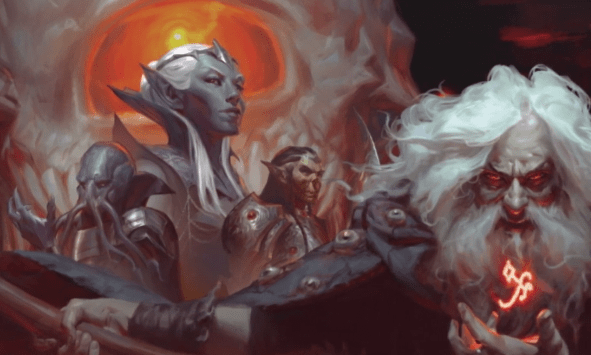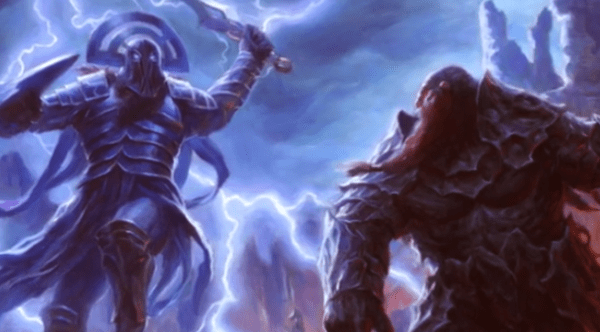Abilities gained through leveling up the Player’s Class in Dungeons and Dragons give whatever Class they had chosen an extra strength in combat that they didn’t have back during the early game of the campaign.
Unfortunately, by the time a Party reaches Level 20, there is normally very little a Dungeon Master can throw at them that can give them a challenge, with some of the Abilities listed below as one of the many reasons why that would be the case. Therefore, this List does not go in any order in terms of Class, but rather which is the most powerful compared to all the others.
12. Unlimited Rages
The Center of the Combat Ability of a Barbarian is the Ability to Rage during combat, Giving them all kinds of resistances and buffs during a fight that can very easily help a combat encounter turn around from a possible loss to a guaranteed victory. However, in a majority of the leveling system of Barbarians, these Rages are numbered to a certain number before the Player has to rest to regain Rages.
Once they reach level 20, the number of Rages capable of being used is no longer restricted, giving them access to Rage however many times they want. Added in with the Level 15 Ability of Persistent Rage preventing the Rage from Ending Early unless the Player chooses to, this Ability can be quite powerful.
However, if a Player sets it upright and a Dungeon Master does not throw several waves at the party like crazy, then a Barbarian can ration out their Rages and never run out of them.

11. Stroke of Luck
When comparing the Luck Feat to any natural abilities within a Classes’ abilities, Stroke of Luck quickly comes to Mind. Giving a Rogue the Ability to succeed a failed roll regardless of the result or what the roll was for can be a powerful tool, especially in the middle of a dangerous combat encounter where a failed roll could very easily kill the Player Character.
However, the Stroke of Luck ability has only a single charge that replenishes per Short Rest, while the Lucky Feat has three charges before requiring a proper recharge through Resting.
So, It would be best for a Rouge to take the Lucky Feat anyways, to give yourself an extra three uses out of the Stroke of Luck or an extra use out of Lucky, depending on how a person sees it.
10. Archdruid
The Archdruid Feature, once it reaches level 20, shares very similar functionality to the Rage of the Barbarian. The Feature through Levels 1-19 has a set number of Wild Shapes that can be used before the Druid has to let them recharge via a long rest.
However, upon reaching Level 20, this changes to an unlimited amount of them to be able to use however they choose. In the same manner as Rage, however, a player could easily ration out their Wild Shapes effectively to never really run out of them, making this final upgrade in the attribute a golden net that could have been worked around naturally. Either way, it is nice to no longer worry about such things by that point.
9. Foe Slayer
The Foe Slayer Feat for the Ranger has always been an interesting one. The Ability allows for the Wisdom Modifier of the Character to be added to either the attack roll or damage roll made against the Favored Enemy Type that the Ranger chose when they first made their Character.
This makes them quite skilled hunters against that particular type of creature, which can be handy in a One-Shot that involves the Favored Enemy type of this Character.

8. Eldritch Master
When the Spell Slots of the Warlock are brought into anything, it is clear they do not have much. However, upon reaching level 20, The Warlock does not have to worry about conserving what little Spell Slots they have anymore, as through the Eldritch Master Ability.
Instead, they can regain any expended spell slots by invoking their patron for one minute. Now, this doesn’t seem like a whole lot to other spell casters who can do that for a long or short rest and have plenty of slots to spare, but this power can make Spell Slot Rationing a thing of the past since all it takes to regain this Ability after it is used is a Long Rest.
7. High Damage Sneak Attack
The biggest strong suit of the Rouge is the Sneak Attack; Capable of dealing tons of damage against an enemy before they can react, Sneak Attacks have the potential to down opponents within a single strike. However, once they reach level 20, the Sneak Attack Damage ramps up. The Sneak Attack Damage goes from the 9d6 of Level 18 to 10d6 of Levels 19 and 20.
Now, yes, technically, the extra Dice are gained once they reach level 19, but since Stroke of Luck can work incredibly well with Sneak Attack, some Dungeon Masters simply choose to skip past Level 19 for Rouge and get them straight to level 20, so then they can get both.
6. Perfect Self
Ki is the ability currency of the Monk, giving them quite a wide array of abilities they can utilize outside and during combat encounters for various feats. However, like many classes with ability currency, the Ki of a Monk can run out, having to be replenished per Long Rest. With reaching Level 20 and gaining the Perfect Self ability, the Monk can replenish their Ki Points every time they roll their initiative for combat.
This way, when a Monk goes into battle, they don’t have to worry about how many Ki points they have left, as they regain them at the beginning of combat and can thus do all of their fancy combat abilities with no imminent risk of running out of them.
5. Twenty Sorcerer Points
Sorcerers have points they can spend to give themselves more Spell Slots in a unique way to aid their spellcasting ability. These Points are solely used for that, and the cost for slots’ exchanges depends on what slot a Sorcerer wants to give themselves through these points.
After reaching Level 20 and gaining the last level they can obtain, the Sorcerer will have 20 of these points. This can give the Sorcerer all kinds of spell slots for them to use however they want, with the only limitation being what the Sorcerer wants to spend them on.

4. 15 Paladin Spell Slots
Paladins have a similar boon to reaching level 20 as the Sorcerers do. Once they reach that level, they will have gained 15 Spell Slots to use however they wish. This isn’t truly an ability like the others, but rather a gradual gift that they gain through their progression in levels, like how the Sorcerer points work. Having this many spell slots allows them to use Divine Smite multiple times without issues.
3. Sacred Oath Feature
Continuing on the Paladin, included with the extra Spell Slots is the final Sacred Oath Feature that they gain. Now, these can vary depending on the Oath they took, from resisting all damage for one minute upon activating it as an action to letting out an Aura that damages frightening creatures within it for massive amounts of damage. These features can make any creature going up against them quite terrified of them.
2. Primal Champion
As the last Barbarian Ability upgraded upon reaching their finals levels, The Strength score and Constitution Score of the Barbarian increased from wherever they were at up to four while also increasing the maximum they can have from 20 to 24.
This increases their health and damage output, giving them even more of a tanky feel, especially if they had built their Character to be the party’s tank.
1. Divine Intervention
Divine Intervention is an ability all players can technically call upon, though it requires insane luck to get it. Upon reaching Level 20 of Cleric, however, this Ability is a guarantee to succeed by removing the roll and simply allowing the Cleric to speak to their Deity and have them grant them a wish of their choosing.
This is effectively limitless as to what they could ask for, with only the Dungeon Master being the limiting factor in what they can ask for.
Conclusion
The final abilities of the different classes within Dungeons and Dragons, upon reaching level 20, can make the characters who gain them insanely powerful, along with making any combat encounters involving them seem trivial at best.
As a result, many people shelve campaigns upon players reaching level 20. However, others can still challenge them to test their new abilities, even if those encounters would be just as powerful and dangerous as the party is in its current state.
